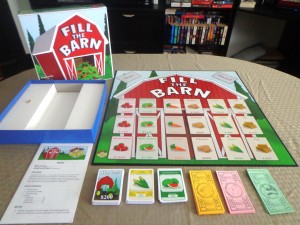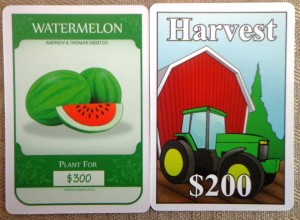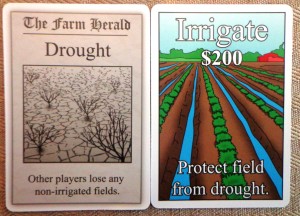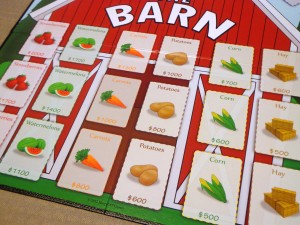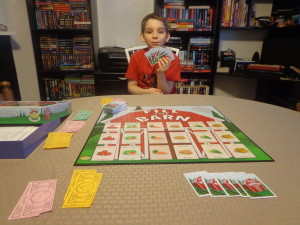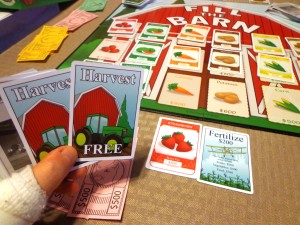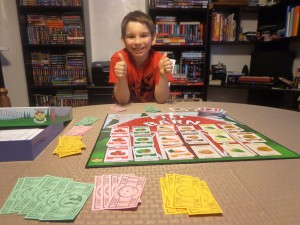There’s been a lot of games focused around farming as of late, but I’m not going to complain. I’ve spent hours days months trying to build the perfect farm on games in the “Harvest Moon” series. Perhaps these type of games appeal to my resource management addiction, who’s to say? In “Fill the Barn”, players will be playing cards and trying to harvest crops to earn money. Before we take a look at this game in closer detail, I’d like to thank Dan Yarrington from Game Salute for providing me with a free review copy.
Components
Game Board – There is one game board, made up of crop spaces large enough to hold player cards. Crops are divided up into rows and each space has a different harvest value. The board also contains spaces for the draw and discard piles.
Cards – There are one hundred and fifteen cards that have a variety of different uses. Some cards are used for harvesting while others can be played offensively or defensively. There are five blank cards in the deck, which players can use to replace lost cards or to create their own card variants.
Money – Paper money is used so that players can keep track of their funds and ultimately, who wins the game. They come in $100, $500, and $1000 denominations.
Paper and Pencil (Not Included) – I recommend having a tablet and pencil close by, as players will need to keep track of the dishing out and repayment of loans throughout the game as needed.
Setup & Gameplay
First, the five blank cards are removed from the deck (assuming you’re not using them for various reasons). After the deck is shuffled, each player receives $1500 in paper money and five cards face-down. To decide a starting player, everyone reveals the number of crop cards in their hands and whoever has the highest number, goes first. Ties go to the younger player.
On a player’s turn, they will:
1) Play a Card & Draw a Card – The player will play one card from their hand, then draw one from the draw pile.
OR
2) Exchange – A player may discard one, two, or three cards and draw that many from the deck.
Crop cards are placed in front of players, to simulate that they’ve been planted. Harvest cards allow a player to move a crop card from their “field” into the barn. There are other cards that affect gameplay, but the main idea is to plant a crop, then harvest it for cash. Planting and harvesting both have costs associated with them (as noted on the cards), so it’s important to keep this in mind when mentally calculating the money you’d receive from the harvest slot.
The game ends when the deck of cards runs out or the board fills up completely with cards. Whoever has the most money after one final round wins the game!
The above is just an overview of the game and doesn’t cover all of the rules found in the manual, but should give you an idea as to what the game is like. For more information, please see the links at the end of this article.
The Review
There aren’t that many components, making clean-up nice and easy. The board and cards themselves are sturdy enough to get the job done and last a while. Some gawk at paper money in general, but the kids and I don’t mind it.
I both liked and disliked “Fill the Barn” and oddly enough, for the same reasons. I really like the idea behind the costs associated with playing cards and the diminishing returns observed during harvests. The game really encourages the use of math, as you’ll be subtracting the costs of the cards you play from the money you receive after placing them on the board. The cards have different prices listed on them and some are even free, making your brain work on a regular basis as you attempt to come up with the best play each turn. The diminishing returns mechanic may force one player to favor a particular crop over another, depending on the circumstances. With the addition of cards that can wipe out a player’s crops or give your own a nice boost, the game is always changing and keeping things fresh.
The luck of the draw coupled with the diminishing returns rule, on the other hand, can be problematic at times. The game is designed so that the first crop in a row earns you the most money, with each subsequent crop in that row earning you less…hence, diminishing returns. However, a player who has the bad luck of not getting a lot of cards they’d need to make plays early on may fall behind. Some of the offensive cards are a bit powerful, allowing you to wipe out all of the crops in an opposing player’s field in one swoop. There are cards in the deck to help protect players from this, but those drought cards may discourage players from playing a lot of cards on their field at one time. While it is a valid strategy to hold onto high cost cards in the hopes of drawing less expensive cards of the same kind, the game (in most cases) rewards those who play first and often.
In the end, “Fill the Barn” is an excellent game geared more towards kids than adults. Despite the above concerns, players can modify the rules as they need to in order to improve their play experience. You could reverse the order in which you play crop cards on the board, going from the bottom up, as opposed to starting at the top going down. This means that players will earn more money from plays towards the end of the game rather than the beginning, giving them something to look forward to at the end of that half hour. Other variants are available on the official website (link below). While the game is geared more towards kids, I found myself wanting to play again. I am finding it to be a good and easy game to play with the kids on family game night. Adults seeking more of a “farming” challenge however should probably look elsewhere.
Final Verdict: 8/10
—
You can learn more about and purchase “Fill the Barn” by visiting the following websites:
http://shop.gamesalute.com/collections/front-page-1/products/fill-the-barn
—

